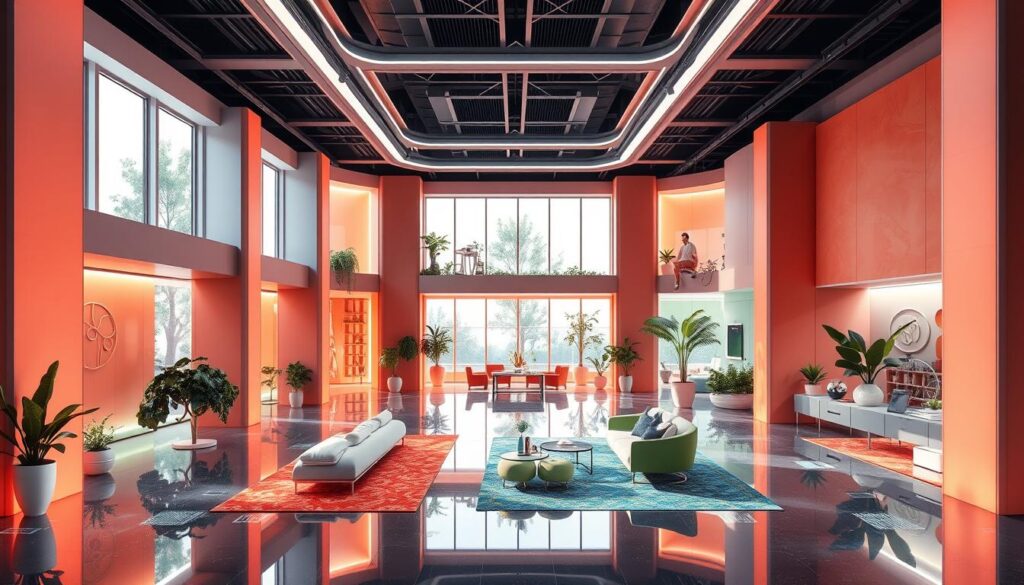The world of interior design is changing fast, thanks to artificial intelligence (AI). This new technology is making a big difference, offering tools that make design work easier and more creative.
AI is changing the game with AI-powered room planning, material selection, and color scheme generation. It’s making the design process more efficient and opening up new possibilities for designers.
But AI’s impact goes beyond the early stages. It’s also changing how designers show their ideas to clients. With AI virtual staging and 3D visualization, collaboration and decision-making are getting better.
Let’s dive into how AI is transforming interior design. We’ll see how these technologies are changing the game for designers and their clients.
Does AI for Interior Design Help the Process Now?
The use of artificial intelligence (AI) in interior design has changed the game. It brings new tools and tech that make designing spaces better. AI helps designers and homeowners in many ways, from making things faster to opening up new creative doors.
AI is especially good at planning rooms and showing what they could look like. It can figure out the best layout for furniture and create detailed 3D images. This lets designers and clients try out different ideas and make better choices, saving time and money.
AI also changes how designers pick materials and colors. It uses trends, what people like, and even the environment to suggest colors and materials. This makes designs more personal and helps make better choices, which is really helpful in interior design.
Exploring AI-Powered Room Planning Tools
The world of *ai-powered room planning* tools has changed how interior designers work. These tools use advanced algorithms to analyze room sizes, furniture, and what users like. They suggest the best ways to arrange furniture to use space well.
These *ai furniture layout* tools save designers a lot of time. They let designers try out different designs fast.
Artificial intelligence helps designers create and check many furniture layouts quickly. These tools look at room size, where doors and windows are, and what users need. They offer personalized advice to make spaces both functional and beautiful.
The mix of *ai-powered room planning* and *ai furniture layout* helps designers make better choices. It makes their work easier and lets them try new ideas. As AI gets better, it will change interior design even more, leading to smarter and more creative designs.
AI and Material Selection
Interior design is changing fast, thanks to *AI-powered material selection tools*. These tools analyze many factors like texture, color, durability, and environmental impact. They help designers pick the best materials for their projects.
Designers use *AI material selection* to make choosing materials easier. These tools search through huge databases. They match the design vision and client wishes to find the right materials.
With *AI material selection*, designers save a lot of time. They can focus on creating designs that meet client needs. These designs use materials that are strong, eco-friendly, and look great. This technology is key for today’s interior designers, helping them work more efficiently and accurately.
AI-Driven Color Scheme Generation
Choosing the right color palette is key in interior design. It can be time-consuming and hard. Luckily, ai color schemes are changing how designers pick colors. AI tools use advanced algorithms to find colors that match the design’s mood, style, and lighting.

These tools save designers a lot of time. They offer unique color combinations that might not have been thought of before. ai color schemes consider color theory and the space’s needs. They suggest palettes that are not only beautiful but also evoke the right emotions.
This lets designers focus on the creative parts of their job. The AI handles the color selection, making the process easier. As interior design evolves, ai color schemes play a bigger role. They help designers work more efficiently, explore new ideas, and deliver amazing results that impress clients.
AI Virtual Staging: A Game-Changer
In the world of interior design, *ai virtual staging* has changed the game. It lets designers show off their ideas in empty spaces. Clients can see how the space will look before anything is moved.
This technology is a big deal. It lets designers try out more ideas, making it easier to decide. Clients can dive into the virtual space, understanding the designer’s vision better. They can give feedback sooner, helping the project move forward.
*Ai virtual staging* also has practical benefits. It saves time and money, and it’s better for the environment. Designers can focus on creativity, not on the logistics of staging. This makes projects more efficient and affordable.
The interior design world is changing fast, and *ai virtual staging* is leading the way. It’s changing how designers show their work and work with clients. This tech is making the design process smoother and improving the client experience. It’s set to shape the future of the industry.
3D Visualization with AI
In the world of interior design, *AI-powered 3D visualization tools* are changing how designers and clients work together. These tools let users see their design ideas come to life. They offer a deep experience that goes beyond just looking at 2D pictures.
These tools use *ai 3d visualization* to create detailed, real-looking images. They show the design, including materials, lighting, and how things fit together. This helps designers make better choices and lets clients see what the space will look like. They can then give important feedback.

The use of *ai 3d visualization* in interior design makes working with clients better. It helps make decisions easier and leads to more successful projects. Designers and clients can dive into the virtual space together. They can tweak design details until it matches their dream.
Enhancing Client Collaboration with AI
The use of *AI interior design tools* has changed how designers work with clients. Interactive design platforms with AI let clients give feedback in real-time. They can also take virtual tours and communicate easily, making it easier to agree on designs.
These tools help build stronger relationships between clients and designers. They lead to happier clients and better project results. Clients can see and interact with designs in a new way. This lets them give feedback and ideas as the design evolves.
AI also makes the design process smoother. It cuts down on the need for repeated changes. Clients can see different versions of the design, add notes, and approve updates easily. This makes the whole process clearer and more collaborative.
The introduction of *AI interior design tools* has brought a new level of teamwork between clients and designers. It allows them to work together better and reach their design goals more easily.
AI-Powered Trend Analysis
In the fast-changing world of interior design, keeping up with trends is key. Luckily, ai interior design tools are here to help. They use AI to spot new trends and guess what’s coming next with great precision.
These tools dig through huge amounts of data, like social media and design magazines. They find new trends and share important insights. This helps designers pick the right colors, materials, and styles for their projects. It makes sure their work stays fresh and exciting.
Thanks to ai interior design tools, designers can always be one step ahead. They can guess what their clients and the design world will like next. This edge can make a big difference, helping designers stand out and lead the way in their field.
Ethical Considerations in AI Interior Design
As *AI* becomes more common in interior design, we must think about its ethics. Designers need to make sure *AI* tools are clear, fair, and protect user privacy. They also need to think about how *AI* might affect jobs and if it could make biases worse in design.
Transparency in *AI* algorithms is a big concern. Designers should know how these algorithms work and make sure they’re fair. Privacy is also key, as *AI* tools might use personal data. Designers must keep this data safe and private.
Another issue is how *AI* might change jobs in interior design. Designers should use *AI* to help, not replace, them. This way, *AI* can make their work better, not worse.
In the end, using *AI* in interior design needs a careful approach. It’s about being open, private, and caring for everyone involved. By tackling these big issues, designers can use *AI* in a way that’s both powerful and right.
The Future of AI in Interior Design
AI interior design tools are getting better, with new features and uses coming up. We’ll see more in generative design and AI with smart homes. Interior designers need to keep up with these changes to use AI’s benefits and solve any problems.
Generative design with AI is very exciting. It lets designers set parameters, and AI comes up with many designs. This could change how we think about design, letting us try new things and find innovative solutions.
AI and smart homes will change how we live. Imagine an AI system that adjusts lights, temperature, and furniture for you. It could make our homes more comfortable and personalized.
But, designers must watch out for ethical issues like privacy and bias. They should be ready to use AI wisely and keep their work creative and fair.
Conclusion
AI is changing interior design in big ways. It makes the design process faster and more creative. It also helps designers work better with clients.
AI tools like room planning and color scheme generation are making a big difference. They help designers try new things and work more efficiently. This makes the design process better for everyone involved.
The future of interior design looks bright with AI. It will mix human creativity with new technology. This will lead to amazing design experiences.


No responses yet